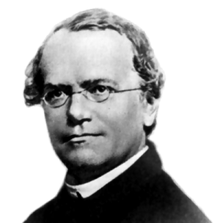
Mendel was a gardener at the monastary, he grew peas. While he was growing the peas, he observed what happened when you breed a plant with one trait against a plant with a different trait. What he found was a set of ratios that are always the same in the offspring.
This is the bit where we could come to those crosses you might remember from high school, but I'm actually going to leave that for another day. I will, however try to explain a bit about Mendelian genetics without resorting to drawing crosses.
Every gene that you have has two copies (unless your a guy, then you X & Y makes thing a bit more complicated). This is because you have paired chromosomes like this:

One of your copies came from your mother and one from your father and they can be slightly different (the different copies are called alleles). For example your parents may have had different coloured eyes, so they might be passing you slightly different version of the eye colour genes. Don't forget that your parents had two copies as well - so they might have different types which could be passed to you.
Let's say you received a blue eye colour allele from your father and a brown eye colour allele from your mother. How can we predict what colour eyes you have?
Well, Mendelian genetics relies on the concept of recessive and dominant alleles. A dominant allele only has to have one copy to show, but a recessive allele need two copies to show. In the case of your eye colour, we know from experiments that the brown allele is dominant and the blue allele is recessive. This means that you would have brown eyes.
Mendel noticed that certain traits in his peas were dominant and some were recessive. Traits he looked at included things like: shape (wrinkled or round) and seed colour (yellow or green).
Unfortunately, although Mendel published his work at the time, it didn't reach the wider scientific community and had to wait until the early 20th century when the same conclusions were independently discovered by other researchers. Previously to this work being discovered it was assumed that traits in the offspring were a merging of the traits in the parents rather than a case of either/or.
The other interesting point to make is that, knowing what we now know about statistics and probability, it appears that Mendel may have either tweaked some of his results or played around with the plants until he got ones which showed exactly the results he wanted - the ratios are just too good, it wouldn't happen in a modern experiment. However, we shouldn't really judge him too harshly, biology in the 19th century was mostly observation and very little planning of experiments, so he probably wasn't doing anything that the others wouldn't have been doing.
No comments:
Post a Comment